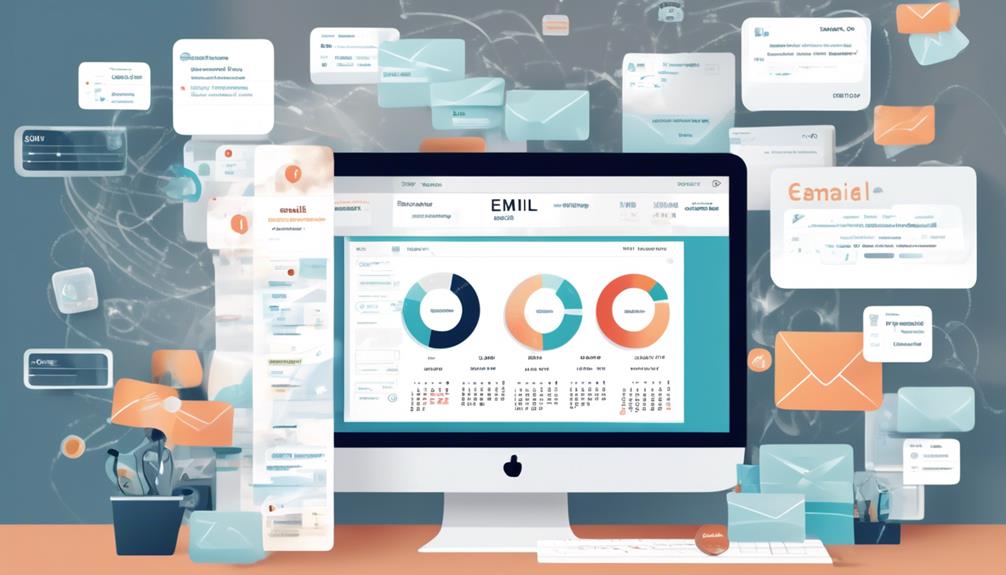Sending emails to potential customers is like planting seeds in a well-maintained garden and watching them grow into beautiful flowers.
I've seen businesses harness the power of email marketing to cultivate relationships with their customers and drive significant revenue.
But how does it really work? The intricacies of crafting compelling content, building an engaged subscriber list, and measuring the impact of each campaign are all part of the equation.
Let's uncover the secrets behind this powerful tool and explore the strategies that make it an indispensable part of modern marketing.
Key Takeaways
- Email marketing is an effective tool for sales conversion, with marketing leaders acknowledging its effectiveness.
- Building an email list through various strategies allows businesses to engage with a broader audience and nurture lasting relationships.
- Crafting compelling content tailored to the audience's needs leads to increased engagement and conversions.
- Email marketing automation streamlines processes, enables personalized content delivery at scale, and enhances customer engagement.
Email Marketing Basics
How can email marketing help businesses build stronger connections with their audience and drive sales conversions?
Well, let me tell you a story about the power of email marketing. Imagine you have a business, and you want to connect with your customers in a meaningful way. You decide to start building an email list, and as you do, you realize the potential it holds. With email marketing, you can reach out to your audience directly, offering them valuable insights, promotions, and personalized content.
Data shows that 47% of marketing leaders acknowledge the effectiveness of email marketing for sales conversion. This isn't just a shot in the dark; it's a proven way to drive sales. By creating targeted marketing campaigns, you can tailor your messages to specific segments of your audience, increasing the likelihood of conversion.
Moreover, email addresses have longer lifespans, providing a consistent way to connect with audiences over time. This means that your message can reach your customers at different stages of their journey, nurturing them towards making a purchase.
With new-age email marketing services, creating and executing campaigns has never been easier. Templates and tools are readily available, making it accessible for businesses of all sizes. In a crowded digital environment, email marketing helps your brand stand out by communicating directly with your customers. It's a personal touch in a digital world.
In essence, email marketing isn't just about sending emails; it's about building relationships and driving sales conversions.
Building an Email List

When it comes to email marketing, one of the most crucial aspects is building an email list.
We use a variety of strategies to attract potential subscribers, such as offering valuable incentives and utilizing opt-in forms on our website and social media platforms.
List Building Strategies
To grow your email list effectively, consider offering compelling incentives or lead magnets to entice visitors and capture their email addresses. This strategy can significantly boost your list building efforts and enhance customer engagement.
Here are some proven list building strategies to help you expand your email list:
- Utilize pop-up forms and landing pages to capture email addresses from website visitors.
- Leverage social media and content marketing to drive traffic and encourage email sign-ups.
- Use gated content, such as ebooks or webinars, to capture email addresses in exchange for valuable resources.
Implementing these strategies can lead to substantial growth in your email list, allowing you to engage with a broader audience and nurture lasting relationships with your subscribers.
Opt-in Forms
Opt-in forms play a crucial role in building an email list. They allow visitors to subscribe to receive updates, promotions, and newsletters. These forms are strategically placed on websites and landing pages, capturing valuable customer information like name and email address.
By obtaining permission from recipients, businesses can engage in ethical and effective email marketing practices. To optimize conversions, compelling calls-to-action and incentives, such as exclusive content or discounts, can be incorporated into the opt-in forms.
Building a quality email list through these forms enables targeted and personalized communication. This fosters better customer relationship management and leads to improved engagement and conversions.
Ultimately, utilizing opt-in forms effectively is fundamental to the success of email marketing. They provide a direct channel for businesses to connect with their audience.
Crafting Compelling Content
Crafting compelling content begins with understanding your audience and crafting content that resonates with their interests and needs. In the world of email marketing, crafting compelling content is the key to engaging and retaining your subscribers.
Here's how we can achieve this:
- Understand Your Audience: Dive deep into understanding your audience's demographics, behaviors, and preferences. This will enable you to tailor your content to their specific needs and interests.
- Tell a Story: People connect with stories, so weave narratives into your content to create an emotional bond with your readers. Use storytelling techniques to make your content relatable, engaging, and memorable.
- Use Compelling Visuals: Visual content is powerful. Incorporate eye-catching images and videos that align with your message. Compelling visuals can significantly enhance the impact of your email content.
Crafting compelling content in email marketing delivers results. By understanding your audience, telling captivating stories, and incorporating engaging visuals, your marketing delivers value and resonates with your subscribers, ultimately leading to increased engagement and conversions.
Measuring Marketing Success

Measuring marketing success requires careful analysis of email campaign metrics, utilizing data to evaluate effectiveness and identify areas for improvement. When it comes to email marketing, tracking open rates is crucial. This metric indicates the percentage of recipients who opened your email, providing valuable insights into the effectiveness of your subject lines and overall content.
Additionally, click-through rates reveal the percentage of recipients who clicked on links within your email, showcasing the level of engagement and interest generated by your content. By leveraging email marketing services to monitor these metrics, you can gain a deeper understanding of your audience's behaviors and preferences.
To effectively measure your email marketing success, it's essential to set specific and measurable goals for your campaigns. Align these goals with your target audience and desired outcomes to ensure that your efforts are focused and purposeful. Regularly monitoring campaign performance using email marketing service and website analytics allows you to make data-driven decisions to optimize your strategies.
Continuously refining your campaigns based on low open rates and other key metrics will help enhance your results and drive better engagement with your audience.
Email Marketing Automation

Utilizing email marketing automation allows businesses to streamline their processes and send personalized, timely emails to subscribers automatically, enhancing customer engagement and driving targeted messaging. With automation software, we can create a seamless experience for our subscribers while optimizing our marketing efforts. Here's how email marketing automation empowers businesses:
- Personalization at Scale: Automation software enables us to deliver tailored content to individual subscribers based on their interactions with our brand, ultimately fostering stronger customer relationships.
- Behavior-Driven Triggers: By setting up automated responses to specific customer actions, such as website visits or purchases, we can ensure that our emails are timely and relevant, maximizing their impact.
- Data-Driven Optimization: Marketing automation tools allow us to analyze customer data, segment our audience effectively, and measure the performance of our email campaigns. This data-driven approach helps us refine our strategies for better engagement and conversion rates.
Incorporating email marketing automation not only saves us time and effort but also empowers us to deliver more personalized and effective communication to our subscribers, ultimately driving our business goals forward.
Utilizing Email Templates

When creating impactful email campaigns, the use of email templates can significantly enhance the efficiency and consistency of our messaging, ensuring a professional and visually appealing presentation to our subscribers. Utilizing email templates streamlines the process of creating professional-looking emails, eliminating the need for advanced design skills. This ensures that our emails maintain a consistent branding and messaging across different campaigns, reinforcing our brand identity and increasing recognition among our subscribers.
Customizability is another key advantage of email templates. They can be tailored to align with specific campaign goals and audience preferences, allowing us to deliver more targeted and personalized content.
Moreover, email templates are responsive, ensuring that our emails display well on various devices and screen sizes, providing a seamless experience for our subscribers.
Strategies for Effective Campaigns

When it comes to crafting effective email campaigns, we've found that targeted audience segmentation, compelling email content, and an effective call-to-action are crucial elements for success.
By segmenting your audience, you can ensure that your messages are tailored to specific groups, increasing the relevance and impact of your emails.
Compelling content and a clear call-to-action further enhance engagement and drive desired outcomes.
These strategies have consistently proven to elevate campaign performance and deliver tangible results.
Targeted Audience Segmentation
To create effective email marketing campaigns, understanding and implementing targeted audience segmentation is crucial for delivering personalized and engaging content to different customer segments.
When you segment your email list, you can tailor your messages based on demographics, behaviors, or preferences. This allows for more personalized and relevant communication, leading to higher engagement and conversion rates.
By understanding the specific needs and interests of different segments, you can craft campaigns that resonate with each group, fostering stronger relationships with your audience.
Effective segmentation strategies can significantly impact your campaign performance, resulting in improved open rates and click-through rates.
Embracing targeted audience segmentation is the key to unlocking the full potential of email personalization and creating impactful connections with your target audience.
Compelling Email Content
After mastering targeted audience segmentation to deliver personalized content, the next step is to focus on crafting compelling email content that captivates recipients and drives engagement.
Compelling email content is the cornerstone of successful email marketing campaigns. It starts with crafting attention-grabbing email subject lines that entice recipients to open and engage with the content.
Engaging and relevant content adds value to the recipient's experience and addresses their needs, fostering a stronger connection with the audience. Visual appeal and mobile responsiveness are crucial for capturing and retaining the recipient's attention.
Personalized and targeted messaging resonates with individual recipients, increasing engagement and conversion rates. Additionally, clear and compelling calls-to-action (CTAs) prompt desired actions, driving the effectiveness of the email campaign.
Effective Call-To-Action
How can you ensure your call-to-action (CTA) prompts an immediate and compelling response from your email recipients?
Crafting an effective call-to-action is crucial for driving engagement and nurturing customer relationships. Here's how you can optimize your CTAs:
- Use actionable language: Employ verbs that encourage immediate action, such as 'Shop Now' or 'Subscribe Today.'
- Communicate value: Clearly convey the benefits or rewards recipients will gain by clicking on the CTA.
- Strategic placement: Position the CTA prominently within your email to ensure it catches the recipient's attention.
Advantages & Disadvantages

Email marketing offers distinct advantages and disadvantages that must be carefully considered in crafting effective campaigns.
The advantages are compelling: permission-based engagement leading to higher conversion rates, direct access to the audience, more control compared to other platforms, personalization capabilities for hyper-targeted campaigns, and easy measurement of campaign success. These benefits make email marketing a powerful tool for businesses to reach and engage their target audience effectively.
However, there are also disadvantages to be mindful of. Tough competition in cluttered inboxes means that standing out can be a challenge. Additionally, the need for an existing email list for effective marketing and the requirement to comply with laws like GDPR, CAN-SPAM, and CCPA can pose significant hurdles. Furthermore, there's a risk of being reported as spam by some subscribers, and delivery and deliverability issues with no guaranteed email deliverability add another layer of complexity.
Understanding these advantages and disadvantages is crucial for devising a successful email marketing strategy. By leveraging the strengths and mitigating the weaknesses, businesses can harness the full potential of email marketing while navigating its challenges.
Essential Email Marketing Metrics

As email marketers, we understand the importance of tracking key metrics to measure the performance of our campaigns. These essential email marketing metrics provide valuable insights into the effectiveness of our strategies and help us make data-driven decisions.
From open rates to conversion rates, each metric plays a crucial role in evaluating the success of our email initiatives.
Key Email Metrics
Analyzing key email metrics is essential for understanding the effectiveness of our email marketing campaigns and making data-driven decisions to optimize performance.
When it comes to email marketing, certain key metrics provide valuable insights into campaign performance:
- Open Rate: This metric measures the percentage of recipients who opened the email, giving us an indication of how engaging our subject lines are and the overall email open performance.
- Click-Through Rate (CTR): CTR measures the percentage of recipients who clicked on a link or CTA within the email, offering insights into recipient engagement and campaign performance.
- Conversion Rate: This metric tracks the percentage of recipients who completed the desired action, reflecting the email's effectiveness in driving conversions and overall campaign performance.
Understanding and leveraging these key email metrics is crucial for optimizing our email marketing efforts and maximizing campaign performance.
Performance Tracking
Upon delving into the realm of email marketing, we embark on a journey of tracking essential metrics that illuminate the performance and effectiveness of our campaigns.
Key to this journey is performance tracking, which allows us to gauge the impact of our email marketing efforts. By closely monitoring metrics such as open rates, click-through rates (CTR), conversion rates, bounce rates, and unsubscribe rates, we gain valuable insights into the engagement levels and actions of our recipients.
Additionally, tracking email deliverability rates is crucial for ensuring that our messages reach the intended inboxes.
These metrics not only provide a snapshot of our current performance but also offer actionable data to refine our strategies, enhance engagement, and drive better results in our email marketing endeavors.
Customer Engagement Techniques

To truly engage customers and foster brand loyalty, personalizing communication is key. When it comes to email marketing, there are several techniques that can significantly enhance customer engagement and drive results. Here are some effective customer engagement techniques to consider:
- Segmentation: Divide your email list into smaller, targeted groups based on demographics, behaviors, or purchase history. By sending personalized content to specific segments, you can tailor your messages to better resonate with each group.
- Interactive Content: Incorporate interactive elements such as polls, quizzes, or surveys within your emails to encourage active participation from recipients. Interactive content not only boosts engagement but also provides valuable insights into customer preferences and interests.
- Loyalty Programs: Rewarding loyal customers with exclusive offers, early access to promotions, or personalized discounts can foster a sense of appreciation and strengthen their connection to your brand.
Email Marketing Tools

As we explore the realm of email marketing tools, we continue our journey to enhance customer engagement and drive impactful results through personalized communication. Email marketing tools are the digital marketer's arsenal, providing a plethora of features and functionalities to streamline campaign creation and execution. These tools offer an array of customizable templates, making it effortless to craft visually appealing and compelling emails.
With automation capabilities, marketers can ensure timely and relevant communication, significantly enhancing the frequency and effectiveness of their email campaigns.
In the world of digital marketing, tracking and measuring the impact of campaigns is paramount, and email marketing tools excel in this aspect. They enable the monitoring of various metrics, such as open rates, click-through rates, and conversions, providing valuable insights into campaign performance. Additionally, these tools offer robust analytics, allowing marketers to delve deep into the effectiveness of their email marketing strategies.
In essence, email marketing tools are indispensable for any digital marketer striving for success in engaging and converting customers. Their ability to simplify campaign creation, enhance personalization, and provide insightful analytics makes them a cornerstone of effective email marketing strategies.
Can You Explain the Process of How Email Marketing Works?
Email marketing definition and purpose involve sending commercial messages to a group of people via email. The process typically includes building a list of email addresses, creating engaging content, and strategically sending out campaigns to drive sales, promote products, or build brand awareness.
Frequently Asked Questions
How Does Email Marketing Make Money?
We make money through email marketing by leveraging targeted campaigns and promotional emails to drive sales conversions and nurture customer relationships. This approach increases brand awareness, boosts product promotion, and enhances customer loyalty, leading to higher revenue.
By analyzing valuable insights and metrics, we measure ROI, engagement rates, and campaign effectiveness, ensuring a maximized revenue potential.
With automation features and personalized messaging, we optimize customer engagement and increase conversion rates.
What Are the 5 Steps of Email Marketing?
We've mastered the 5 steps of email marketing, starting with defining clear goals aligned with our overall strategy.
We carefully choose the right campaign type, craft engaging content, and measure performance with precision.
Automation and optimization are our secret weapons, enhancing timeliness, relevance, and frequency.
Our journey through these steps is like navigating a complex puzzle, carefully aligning each piece to create a powerful marketing strategy.
What Are the 4 Types of Email Marketing?
Sure, the four types of email marketing are newsletters, offers, announcements, and event invitations.
Newsletters are for keeping existing customers engaged and informed.
Offers are about new deals and promotions.
Announcements are for introducing new products, services, or features.
Event invitations are to increase awareness and encourage event registration.
Each type serves a specific purpose in engaging and retaining customers, and when used strategically, they can significantly boost business success.
How to Successfully Do Email Marketing?
We successfully do email marketing by:
- Defining clear goals
- Selecting the right campaign types
- Building a quality contact list
We design visually appealing emails, analyze performance, and use automation for timely communication.
By understanding the value of email marketing, we achieve better results, build relationships, and drive sales while adhering to regulations.
Email marketing is a powerful tool that, when used effectively, can lead to significant brand success and growth.
Conclusion
In conclusion, email marketing is like a well-crafted puzzle, with each piece working together to create a powerful message. One of the most important email marketing tips is to ensure that all elements of the email, including the subject line, content, and call-to-action, are cohesive and compelling. Another tip is to regularly analyze and optimize your email campaigns to ensure that they are effectively reaching and resonating with your target audience. By following these tips, you can seamlessly integrate all the puzzle pieces of email marketing to drive successful results for your business.
As businesses, we have the tools and knowledge to connect with our audience in a meaningful way, driving results and building relationships.
With the right strategy and tools in place, we can unlock the potential of email marketing and continue to engage and inspire our customers.
It's like having a secret formula for success at our fingertips.










